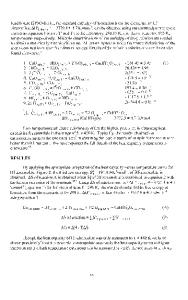Ion-beam irradiation of Gd 2 Sn 2 O 7 and Gd 2 Hf 2 O 7 pyrochlore: Bond-type effect
- PDF / 434,946 Bytes
- 6 Pages / 612 x 792 pts (letter) Page_size
- 35 Downloads / 365 Views
K.B. Helean Department of Chemical Engineering and Materials Science, The University of California, Davis, California 95616 (Received 23 December 2003; accepted 27 February 2004) 4+ Ceramics with III-IV pyrochlore compositions, A3+ 2 B2 O7 (A ⳱ Y and rare earth elements; B ⳱ Ti, Zr, Sn, or Hf), show a wide range of responses to ion-beam irradiation. To evaluate the role of the B-site cations on the radiation stability of the pyrochlore structure-type, Gd2Sn2O7 and Gd2Hf2O7 have been irradiated by 1 MeV Kr+. The results are discussed in terms of the ionic size and type of bonding of Sn4+ and Hf4+ and compared to previous results for titanate and zirconate pyrochlores. Gd2Sn2O7 is sensitive to ion beam–induced amorphization with a critical amorphization dose of approximately 3.4 displacements per atom (dpa) (2.62 × 1015 ions/cm2) at room temperature and a critical amorphization temperature of approximately 350 K. Gd2Hf2O7 does not become amorphous at a dose of approximately 4.54 displacement per [lattice] atom (3.13 × 1015 ions/cm2) at room temperature, but instead is transformed to a disordered fluorite structure upon ion-beam irradiation. Although the radius ratio of the A- to B-site cations provides a general indication of the type of radiation response of different pyrochlore compositions, the results for Gd2Sn2O7 emphasize the importance of bond type, particularly the covalency of the 〈Sn–O〉 bond in determining the radiation response.
I. INTRODUCTION
The pyrochlore structure displays an extremely wide range of chemistries,1,2 and typical compositions for III– 4+ 3+ ⳱ Y and rare IV pyrochlores include: A3+ 2 B2 O7(A 4+ earth elements; B ⳱ Ti, Zr, Sn, or Hf). These compositions have many potential applications as ionic conductors,1–4 dielectrics,5 catalysts,6 thermal barrier coatings on ceramics,7 and as actinide host phases.8–10 Many of the properties depend on the extent of disordering among the A- and B-site cations and the oxygen vacancies.1 Of these compositions, the titanate and zirconate pyrochlores have received considerable attention as potential phases for the immobilization of plutonium and other actinides.10–12 Because of the alpha-decay of actinides, there have been extensive studies of the radiation stability of the different pyrochlore compositions (see Ref. 13 for a recent review). Many pyrochlore compositions are sensitive to ion beam damage and can be amorphized at
a)
Address all correspondence to this author. e-mail: [email protected] DOI: 10.1557/JMR.2004.0178 J. Mater. Res., Vol. 19, No. 5, May 2004
http://journals.cambridge.org
Downloaded: 11 Mar 2015
a relatively low dose [e.g., ∼0.2 displacements per atom (dpa) for Gd2Ti2O7],14,15 but certain compositions are remarkably “resistant” to ion beam irradiation–induced amorphization and instead disorder to the defect fluorite structure upon ion irradiation.10,16,17 In the binary system Gd2(Ti2−xZrx)O7,16,17 the radiation “resistance” increases dramatically with the substitution of Zr for Ti, until the pure end-member, Gd2Zr2O7, cannot be
Data Loading...











